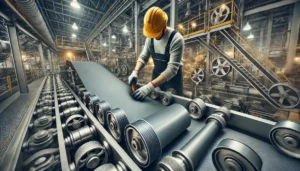Pipe fittings like elbows, tees, reducers, caps and stub endings are key components of piping systems as they allow the pipes to be securely joined or brought in different angles and sizes. The elbows, tees, reducers, caps and stub ends manufacturing processes will depend on the type of the fitting, the size and the material it is made of as well as the application intended. These methods are useful in producing the fittings in adequate quality for service in various industries. This guide gives an overview of the various elbow, tee, reducer, cap and stub end manufacturing processes whereby their production in industry is enhanced.
General Overview of Pipe Fittings Manufacturing
Pipe fittings are made from seamless pipes or welded pipes with filler material with the exception of ERW (Electric Resistance Welded) pipes and EFW( Electric Fusion Welded) pipes as they are not suitable for this work. However, in the case of larger diameter fittings the use of plates instead of pipes is often preferred. The methods used in the production of worked components are divided into two – hot forming methods which include pipe stamping where materials are subjected to high temperatures and reshaped, and cold forming methods where a material is worked at room temperature and mechanical force is applied to shape it.
Some Elbow Pipe Fittings and Their Manufacturing Process
Pipe Elbows
Pipe Elbows possess a number of manufacturing techniques that can be used, considering elbow size, material composition, and wall thickness. One such technique is the mandrel hot forming method. This PP compression technique involves inserting a pipe in a die, which is subsequently warm, then pushing using the hydraulic force. By means of this method, the pipe can be deformed from bending and expanded at the same time; thus, a variety of elbow bend diameters can be achieved. Another technique that can be used especially for a small-to-medium-size stainless pipe fittings elbow is the extrusion method. Cold working is used here, as the pipe is forced through a die to obtain the required elbow shape. The induction method, on the other hand, makes use of hot forming die bending on thick walled elbows. Here, a pipe is heated up to around 200°C and then flooded in a die. The heat softens the wall material enough to make it easy to bend the die.
Tees
A tee branch could be defined as a type of deviation where the fitment is T shaped and has three arms of equal or unequal diameter. A tee branch could be defined as a type of deviation where the fitment is T shaped and has three arms of equal or unequal diameter. There are a few methods which aim to make a tee junction such as a hydraulic bulge method in which one end of a tee is fitted as per the other. The metal pipe is placed in a die and then filled with a liquid and the whole structure is pressurized to an extent that a branch outlet gets formed. The final shape where a top is supported and the bottom is cylindrical is only ideal for thin light more than 3 inches tees . Despite being rapid and efficient , this method is not cost optimal for thicker material tees due to insufficient economics. However, if thicker materials are required hot extrusion methods are suitable and the final outcome is satisfactory. The hot extrusion method forms a t shape branched part using a single tee pump mounted onto a sub. Always use pressing dies that fit snugly against the pipes so they can extrude them outwards. During operations , precisely sized and shaped pistons adjust the width of the opened output ports in keeping uniform portions.
Reducers
Being made from a pipe using an external die one end is pressed between two die faces to make an ending junction that has a smaller diameter, this in turn is assembled into a sub while pluging the remaining ports into the fitting. This configuration is generally used on external sizes that are small to medium. There are two outer dies and the second die allows for the purpose of forming plug ports on a sub.
Caps
Differentiating from the d fittings, caps provide a closed end on a multitude of connections and ports while d fittings provide an open end. However, there is an economical and technical way to produce caps and that way is to use the deep drawing method. In order to maintain a consistent thickness of each scribed wall throughout the drawn outline the bulk metal mass is offered a cylindrical cap that allows for the deep drawing die to work more effectively while still formed into shape. This design is optimized for caps that have many welds on them and as a result are suitable for deep welding submersible piping applications.
Stub Ends
Stub ends, also referred to as flanges, are made from the flaring method whereby the end of the pipe is flared to a given measurement to ensure it fits onto the flange face. They are also available in forged forms and can be machined to final dimensions to heave strength and endurance for use in critical applications.
Specialized Methods for Pipe Fittings
The UO or single weld seam method is commonly referred as UO because it entails shaping plates to a U as well as O and thereafter welding along the seam. Other methods include the Monaka or double weld seam method which is often used for larger diameter elbow as well as tee fittings. Fittings with larger diameters have structural integrity due to large resistance and welded strength, thus utilizing two weld seams to join them.
Heat Treatment for Pipe Fittings
Pipe fittings especially those created through cold working methods tend to require heat treatment in order to enhance their mechanical properties. Such procedures include normalising where ductility and toughness are increased while omega quenched strength followed by tempering as well. Another process is solution annealing which restores the capacity for corrosion while stress relieving removes the residual stresses and ensures that the fittings are effective long term use.
How to Choose a Manufacturing Process
There are a variety of factors that are taken into account when selecting a manufacturing process, such as the material type, size, thickness and the application requirements. The three fittings types, namely stainless steel, carbon steel, and alloy steel may be subjected to different processes because of their characteristics. The size of the fitting dictates the method of manufacturing, for example, smaller and thinner fittings are produced by cold forming methods and larger or thicker ones are hot formed. To attain the required performance and safety levels for high-pressure high-temperature applications, specific forming methods are employed.
Final Remarks
The different categories of fittings incorporate different manufacturing processes known as piping components. The processes range from the elbow being manufactured by the mandrel methods to the caps which are made by deep drawing. These methods have been adapted to enable the reliable performance of pipe fittings in harsh environments thus the performance and efficiency of the piping system as a whole is preserved.
In uniformity with best industry practices, we at Induskart make sure that our pipe fittings are of the best quality. Even if you require elbows, tees, reducers or other fittings, we offer you secure and reliable solutions that can last for a long time.










